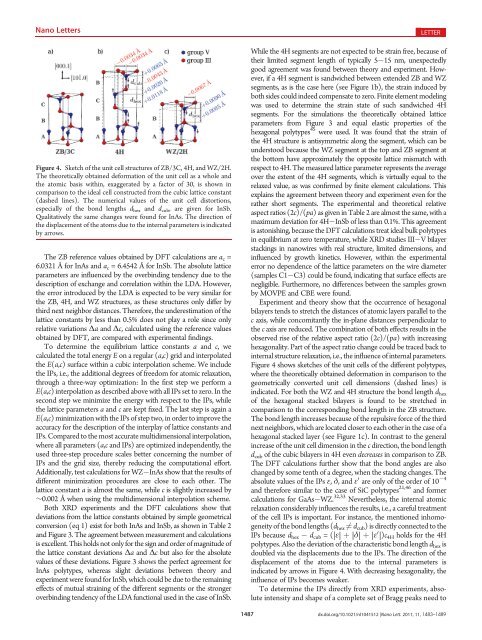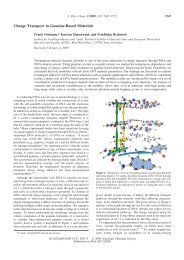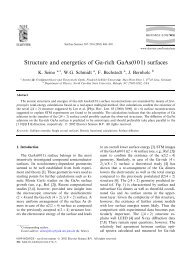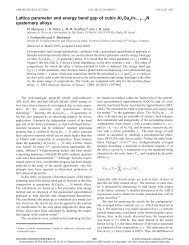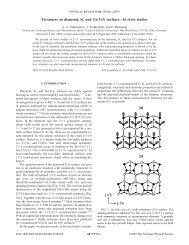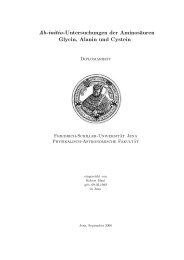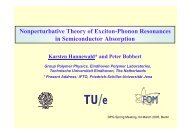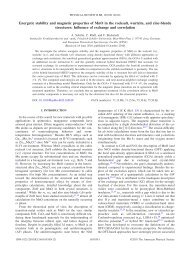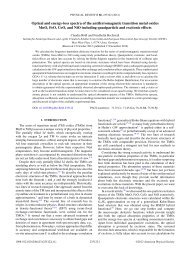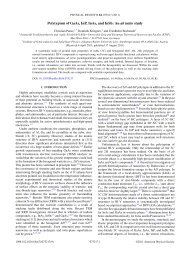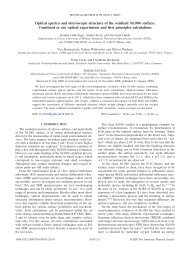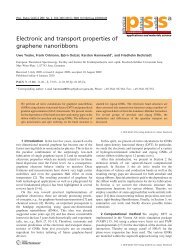Unit Cell Structure of Crystal Polytypes in InAs and InSb Nanowires
Unit Cell Structure of Crystal Polytypes in InAs and InSb Nanowires
Unit Cell Structure of Crystal Polytypes in InAs and InSb Nanowires
Create successful ePaper yourself
Turn your PDF publications into a flip-book with our unique Google optimized e-Paper software.
Nano Letters<br />
Figure 4. Sketch <strong>of</strong> the unit cell structures <strong>of</strong> ZB/3C, 4H, <strong>and</strong> WZ/2H.<br />
The theoretically obta<strong>in</strong>ed deformation <strong>of</strong> the unit cell as a whole <strong>and</strong><br />
the atomic basis with<strong>in</strong>, exaggerated by a factor <strong>of</strong> 30, is shown <strong>in</strong><br />
comparison to the ideal cell constructed from the cubic lattice constant<br />
(dashed l<strong>in</strong>es). The numerical values <strong>of</strong> the unit cell distortions,<br />
especially <strong>of</strong> the bond lengths d hex <strong>and</strong> d cub , are given for <strong>InSb</strong>.<br />
Qualitatively the same changes were found for <strong>InAs</strong>. The direction <strong>of</strong><br />
the displacement <strong>of</strong> the atoms due to the <strong>in</strong>ternal parameters is <strong>in</strong>dicated<br />
by arrows.<br />
The ZB reference values obta<strong>in</strong>ed by DFT calculations are a c =<br />
6.0321 Å for <strong>InAs</strong> <strong>and</strong> a c = 6.4542 Å for <strong>InSb</strong>. The absolute lattice<br />
parameters are <strong>in</strong>fluenced by the overb<strong>in</strong>d<strong>in</strong>g tendency due to the<br />
description <strong>of</strong> exchange <strong>and</strong> correlation with<strong>in</strong> the LDA. However,<br />
theerror<strong>in</strong>troducedbytheLDAisexpectedtobeverysimilarfor<br />
the ZB, 4H, <strong>and</strong> WZ structures, as these structures only differ by<br />
third next neighbor distances. Therefore, the underestimation <strong>of</strong> the<br />
lattice constants by less than 0.5% does not play a role s<strong>in</strong>ce only<br />
relative variations Δa <strong>and</strong> Δc, calculated us<strong>in</strong>g the reference values<br />
obta<strong>in</strong>ed by DFT, are compared with experimental f<strong>in</strong>d<strong>in</strong>gs.<br />
To determ<strong>in</strong>e the equilibrium lattice constants a <strong>and</strong> c, we<br />
calculated the total energy E on a regular (a,c) grid <strong>and</strong> <strong>in</strong>terpolated<br />
the E(a,c) surface with<strong>in</strong> a cubic <strong>in</strong>terpolation scheme. We <strong>in</strong>clude<br />
the IPs, i.e., the additional degrees <strong>of</strong> freedom for atomic relaxation,<br />
through a three-way optimization: In the first step we perform a<br />
E(a,c) <strong>in</strong>terpolation as described above with all IPs set to zero. In the<br />
second step we m<strong>in</strong>imize the energy with respect to the IPs, while<br />
the lattice parameters a <strong>and</strong> c are kept fixed. The last step is aga<strong>in</strong> a<br />
E(a,c) m<strong>in</strong>imization with the IPs <strong>of</strong> step two, <strong>in</strong> order to improve the<br />
accuracy for the description <strong>of</strong> the <strong>in</strong>terplay <strong>of</strong> lattice constants <strong>and</strong><br />
IPs. Compared to the most accurate multidimensional <strong>in</strong>terpolation,<br />
where all parameters (a,c <strong>and</strong> IPs) are optimized <strong>in</strong>dependently, the<br />
used three-step procedure scales better concern<strong>in</strong>g the number <strong>of</strong><br />
IPs <strong>and</strong> the grid size, thereby reduc<strong>in</strong>g the computational effort.<br />
Additionally, test calculations for WZ <strong>InAs</strong> show that the results <strong>of</strong><br />
different m<strong>in</strong>imization procedures are close to each other. The<br />
lattice constant a is almost the same, while c is slightly <strong>in</strong>creased by<br />
∼0.002 Å when us<strong>in</strong>g the multidimensional <strong>in</strong>terpolation scheme.<br />
Both XRD experiments <strong>and</strong> the DFT calculations show that<br />
deviations from the lattice constants obta<strong>in</strong>ed by simple geometrical<br />
conversion (eq 1) exist for both <strong>InAs</strong> <strong>and</strong> <strong>InSb</strong>, as shown <strong>in</strong> Table 2<br />
<strong>and</strong> Figure 3. The agreement between measurement <strong>and</strong> calculations<br />
is excellent. This holds not only for the sign <strong>and</strong> order <strong>of</strong> magnitude <strong>of</strong><br />
the lattice constant deviations Δa <strong>and</strong> Δc but also for the absolute<br />
values <strong>of</strong> these deviations. Figure 3 shows the perfect agreement for<br />
<strong>InAs</strong> polytypes, whereas slight deviations between theory <strong>and</strong><br />
experiment were found for <strong>InSb</strong>, which could be due to the rema<strong>in</strong><strong>in</strong>g<br />
effects <strong>of</strong> mutual stra<strong>in</strong><strong>in</strong>g <strong>of</strong> the different segments or the stronger<br />
overb<strong>in</strong>d<strong>in</strong>g tendency <strong>of</strong> the LDA functional used <strong>in</strong> the case <strong>of</strong> <strong>InSb</strong>.<br />
LETTER<br />
While the 4H segments are not expected to be stra<strong>in</strong> free, because <strong>of</strong><br />
their limited segment length <strong>of</strong> typically 5 15 nm, unexpectedly<br />
good agreement was found between theory <strong>and</strong> experiment. However,<br />
if a 4H segment is s<strong>and</strong>wiched between extended ZB <strong>and</strong> WZ<br />
segments,asisthecasehere(seeFigure1b),thestra<strong>in</strong><strong>in</strong>ducedby<br />
both sides could <strong>in</strong>deed compensate to zero. F<strong>in</strong>ite element model<strong>in</strong>g<br />
was used to determ<strong>in</strong>e the stra<strong>in</strong> state <strong>of</strong> such s<strong>and</strong>wiched 4H<br />
segments. For the simulations the theoretically obta<strong>in</strong>ed lattice<br />
parameters from Figure 3 <strong>and</strong> equal elastic properties <strong>of</strong> the<br />
hexagonal polytypes 45 were used. It was found that the stra<strong>in</strong> <strong>of</strong><br />
the 4H structure is antisymmetric along the segment, which can be<br />
understood because the WZ segment at the top <strong>and</strong> ZB segment at<br />
the bottom have approximately the opposite lattice mismatch with<br />
respect to 4H. The measured lattice parameter represents the average<br />
over the extent <strong>of</strong> the 4H segments, which is virtually equal to the<br />
relaxed value, as was confirmed by f<strong>in</strong>ite element calculations. This<br />
expla<strong>in</strong>s the agreement between theory <strong>and</strong> experiment even for the<br />
rather short segments. The experimental <strong>and</strong> theoretical relative<br />
aspect ratios (2c)/(pa) as given <strong>in</strong> Table 2 are almost the same, with a<br />
maximum deviation for 4H <strong>InSb</strong> <strong>of</strong> less than 0.1%. This agreement<br />
is astonish<strong>in</strong>g, because the DFT calculations treat ideal bulk polytypes<br />
<strong>in</strong> equilibrium at zero temperature, while XRD studies III Vbilayer<br />
stack<strong>in</strong>gs <strong>in</strong> nanowires with real structure, limited dimensions, <strong>and</strong><br />
<strong>in</strong>fluenced by growth k<strong>in</strong>etics. However, with<strong>in</strong> the experimental<br />
error no dependence <strong>of</strong> the lattice parameters on the wire diameter<br />
(samples C1 C3) could be found, <strong>in</strong>dicat<strong>in</strong>g that surface effects are<br />
negligible. Furthermore, no differences between the samples grown<br />
byMOVPE<strong>and</strong>CBEwerefound.<br />
Experiment <strong>and</strong> theory show that the occurrence <strong>of</strong> hexagonal<br />
bilayers tends to stretch the distances <strong>of</strong> atomic layers parallel to the<br />
c axis, while concomitantly the <strong>in</strong>-plane distances perpendicular to<br />
the c axis are reduced. The comb<strong>in</strong>ation <strong>of</strong> both effects results <strong>in</strong> the<br />
observed rise <strong>of</strong> the relative aspect ratio (2c)/(pa) with<strong>in</strong>creas<strong>in</strong>g<br />
hexagonality. Part <strong>of</strong> the aspect ratio change could be traced back to<br />
<strong>in</strong>ternal structure relaxation, i.e., the <strong>in</strong>fluence <strong>of</strong> <strong>in</strong>ternal parameters.<br />
Figure 4 shows sketches <strong>of</strong> the unit cells <strong>of</strong> the different polytypes,<br />
where the theoretically obta<strong>in</strong>ed deformation <strong>in</strong> comparison to the<br />
geometrically converted unit cell dimensions (dashed l<strong>in</strong>es) is<br />
<strong>in</strong>dicated. For both the WZ <strong>and</strong> 4H structure the bond length d hex<br />
<strong>of</strong> the hexagonal stacked bilayers is found to be stretched <strong>in</strong><br />
comparison to the correspond<strong>in</strong>g bond length <strong>in</strong> the ZB structure.<br />
The bond length <strong>in</strong>creases because <strong>of</strong> the repulsive force <strong>of</strong> the third<br />
next neighbors, which are located closer to each other <strong>in</strong> the case <strong>of</strong> a<br />
hexagonal stacked layer (see Figure 1c). In contrast to the general<br />
<strong>in</strong>crease <strong>of</strong> the unit cell dimension <strong>in</strong> the c direction, the bond length<br />
d cub <strong>of</strong> the cubic bilayers <strong>in</strong> 4H even decreases <strong>in</strong> comparison to ZB.<br />
The DFT calculations further show that the bond angles are also<br />
changed by some tenth <strong>of</strong> a degree, when the stack<strong>in</strong>g changes. The<br />
absolute values <strong>of</strong> the IPs ε, δ,<strong>and</strong>ε 0 are only <strong>of</strong> the order <strong>of</strong> 10 4<br />
<strong>and</strong> therefore similar to the case <strong>of</strong> SiC polytypes 21,46 <strong>and</strong> former<br />
calculations for GaAs WZ. 32,33 Nevertheless, the <strong>in</strong>ternal atomic<br />
relaxation considerably <strong>in</strong>fluences the results, i.e., a careful treatment<br />
<strong>of</strong> the cell IPs is important. For <strong>in</strong>stance, the mentioned <strong>in</strong>homogeneity<br />
<strong>of</strong> the bond lengths (d hex 6¼ d cub ) is directly connected to the<br />
IPs because d hex d cub =(|ε| þ |δ| þ |ε 0 |)c 4H holds for the 4H<br />
polytypes. Also the deviation <strong>of</strong> the characteristic bond length d hex is<br />
doubled via the displacements due to the IPs. The direction <strong>of</strong> the<br />
displacement <strong>of</strong> the atoms due to the <strong>in</strong>ternal parameters is<br />
<strong>in</strong>dicated by arrows <strong>in</strong> Figure 4. With decreas<strong>in</strong>g hexagonality, the<br />
<strong>in</strong>fluence <strong>of</strong> IPs becomes weaker.<br />
To determ<strong>in</strong>e the IPs directly from XRD experiments, absolute<br />
<strong>in</strong>tensity <strong>and</strong> shape <strong>of</strong> a complete set <strong>of</strong> Bragg peaks need to<br />
1487 dx.doi.org/10.1021/nl1041512 |Nano Lett. 2011, 11, 1483–1489


